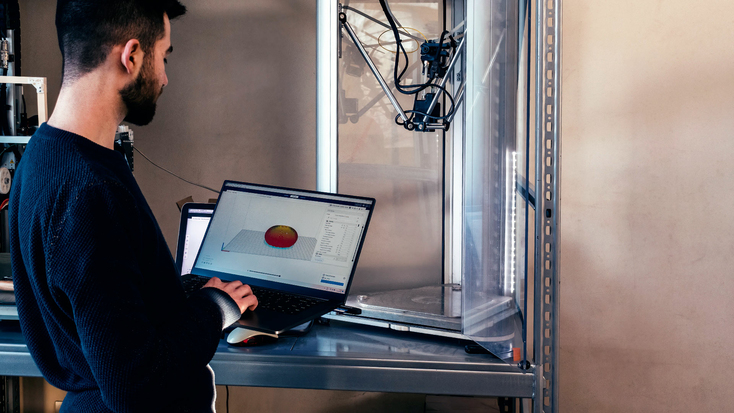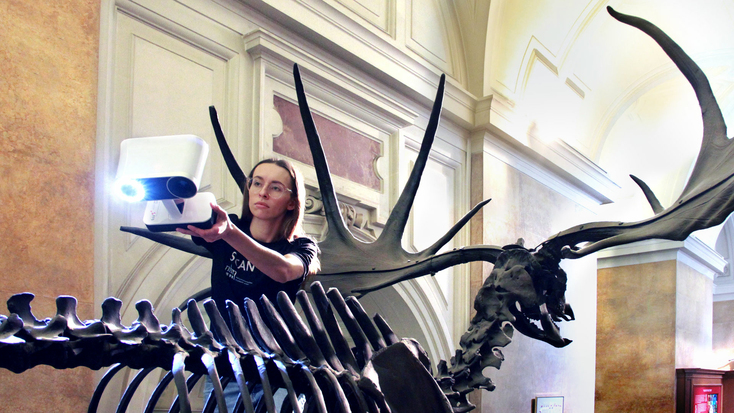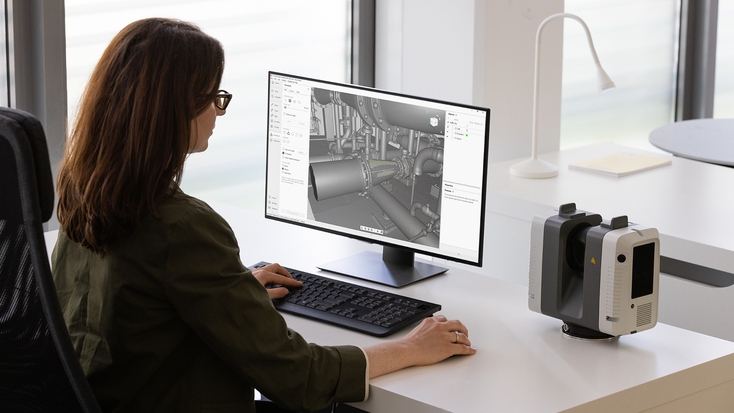Selecting the right 3D scanners for successful 3D printing
When it comes to 3D printing, your 3D scanner plays a crucial role alongside the right software. Here’s a guide to the best 3D scanners, put together to help you find your perfect solution and make the most of it so you can get 3D-printer-ready digital models in nothing flat.
Why use 3D scanning for additive manufacturing?

A 3D printing pipeline starts with a 3D model, which is a file you feed to your 3D printer. Without a model, there’d be nothing to print out. There are two ways to obtain a printable 3D model: create one from scratch in CAD/3D modeling software or scan/photograph an actual object. Either way, you’ll need to make sure your model is watertight, meaning its surface is uniform and has no gaps. So, if your 3D printing workflow suggests making copies of scanned objects, the choice of a 3D scanning tool can turn your job either into a piece of cake or a nightmare. Any surface areas the scanner failed to pick up will need to be modeled by hand.
The role of 3D scanners within an additive manufacturing workflow is not confined to supplying printers with models. Oftentimes, scanners are used to inspect 3D-printed parts and validate the quality of your 3D printer. Does it do a good job producing 3D printouts to specification? To find it out, scan one and create a 3D model from the scans in your 3D data processing software. Top-tier solutions, like Artec Studio, offer a selection of tools to carry out point-to-point measurements, calculate the volume and surface area of your model, check the thickness of manufactured parts – you name it.
One of the key software features in inspection is heatmap comparison, where you superimpose the model your part was printed out from and the model of the part created post-print. Any deviations between the shapes of the two will be highlighted in color, and the software will show you exact deviation values in any given area and even calculate whether the 3D-printed part falls within tolerances you set.

As 3D printing technology evolves and its application scope expands, it becomes part and parcel of a growing number of industries, allowing businesses to resolve new challenges and providing invaluable gains in productivity and quality, which would be hard to achieve otherwise.
Key point
Professional 3D scanners and software play an essential part in a 3D printing workflow, from creating watertight 3D models of real-world objects to inspecting and validating the quality of 3D-printed parts, helping businesses in various industries boost productivity and optimize resource usage.
The importance of precision 3D models for 3D printing is demonstrated through use cases across a variety of industries, from manufacturing to healthcare to heritage preservation, and much more. Quality 3D scans can even transform lives! For example, scans made with Artec Eva lie at the root of a revolutionary method of designing and printing bespoke masks for children with severe facial burns, facilitating faster healing of the skin.

Elsewhere, 3D scanning and printing enable retrofitting heavy machinery, bringing art and design ideas to life, modifying cars to improve their performance, and even creating prostheses for animals.
With a host of options available on the market today, selecting a scanner that fits your bill may strike you as a daunting mission. This article is here to provide you with a list of criteria to factor in and help you make a mindful choice.
What to consider when choosing a 3D scanner for 3D printing?
Depending on your specific application, some factors can be prioritized over others. The following checklist focuses on those essential for any 3D scanning & printing project, with certain application specifics accentuated.

Accuracy
In most 3D printing applications, especially if we talk manufacturing, data accuracy is key. If a 3D-printed part doesn’t click into place snuggly, you can just throw it away. Likewise, a prosthetic device that does not replicate the anatomy of the wearer’s body is likely to cause discomfort and get discarded before long. Make sure you are aware of tolerances required to successfully complete additive manufacturing projects in your field, and invest in a 3D data capture solution that guarantees unfaltering accuracy. Artec 3D offers a line-up of professional 3D scanners featuring different accuracy specifications, which can be explored here.
Speed
The higher the ‘frames per second,’ or FPS rate of your scanner, the more snapshots it takes. With scanners like Artec Point, the value of this parameter can reach an astounding 120 FPS. Lightning-fast data capture enables you to scan more within tight timeframes. In addition to speed, look up a scanner’s field of view. The larger it is, the larger surface areas the scanner will cover, saving you time during scanning sessions.
Resolution
Resolution is commonly defined as the shortest distance between any two closest points within a point cloud or between any two closest vertices of the polygons a 3D mesh model is made up of. Therefore, thorough surface capture translates into the sharpness of the final 3D model. Picking up the most subtle surface details, a submillimeter-precise 3D scanner provides your 3D printer with enough 3D data to minimize error risk during printing.

Portability
The easier your 3D scanning hardware is to deploy, the faster you can get down to scanning. Make sure you can take your scanner along and keep it powered up for a long enough time if you’re planning to scan in the field. An extra battery and charger may come in particularly useful. The light weight of your handheld scanner would add up to scanning convenience. Lighter models, however, would most certainly require wiring up to a laptop to stream data to 3D scanning software in real time. Wireless scanners may be heavier, yet come with onboard computers and do not need to be connected to a laptop. Portability is a valued feature in a range of use case scenarios: from scanning patients in hospitals to digitizing archeological sites and individual artifacts to maneuvering around fragile museum exhibits to capture them from different angles.

Ease of use
An intuitive 3D scanner saves you loads of time on learning how to operate it, which is especially relevant if the scanner is shared within a team, and multiple people may be using it. Likewise, ease of use proves to be particularly valuable when you need to scan batches of items. One of the simplest 3D data capture technologies to pick up is wireless scanning with Artec Leo. Equipped with a touchscreen, Leo takes scanning ease as close as possible to shooting a video with your smartphone. Desktop solutions like Artec Micro II simplify the process even more. Micro II automatically scans an object placed inside it, calculating the best angles to take shots from in order to ensure the surface is captured in full and no detail is missed.
Versatility

A versatile scanner is capable of delivering quality 3D scans of objects big and small. In addition to scanning a range of objects, some applications require scanning people, meaning the scanning technology should be contactless and safe for the eyes. Scanners that meet these requirements include Artec Leo, Artec Spider II, and Artec Eva.
Scanning environments differ as well: you might need to scan both indoors and outdoors. For some uses like 3D printing figurines, textured, full-color scans are absolutely necessary, while with automotive parts, for example, color capture would be of little to no relevance. Consider any possible scenarios where you might need a 3D scanner, and choose one that will make it possible to achieve the results you aim for.

3D scanning for additive manufacturing as an investment
Your 3D scanner of choice should be able to last for years, delivering high-quality results every single time, and therefore is very unlikely to come with a low price tag. At the same time, a 3D scanner is not just a pricey piece of hardware. It’s an investment that will enable you to save work hours on manual 3D modeling or taking measurements by hand.

You are investing in a product that should guarantee the success of your projects, so we recommend you take a moment to do some research on your own, browse through 3D models created with different scanners, look up user feedback, and find answers to a few important questions. Is the scanner brand touted as reliable? Does the manufacturer offer efficient customer support? What do clients have to say about the products? Is the accompanying software capable of handling large datasets without errors or glitches? Does it offer a sufficient toolset, or you might have to purchase an extra piece of software for your workflow?
Ultimately, try out the scanner(-s) you intend to purchase by arranging a live demo with the manufacturer or a reseller. Alternatively, you can see scanners in action at tradeshows. Try scanning sample objects and processing the data, which is the best way to find out whether the scanner lives up to your expectations and whether your investment will pay off in the long run.
3D printing dental implants, jewelry, and small industrial parts with intricate geometry

When every micron counts, and you need to capture the tiniest items, such as jewelry, dental implants, or other very small objects, your best bet is a meticulous metrology-grade 3D solution, such as the desktop Artec Micro II or the portable Artec Spider II. Micro II yields 5-micron accuracy for full-color 3D models of small industrial parts or dental items, integrating photogrammetry for next-level realism. In turn, the newest ultra-high-resolution handheld Spider II easily captures complex objects, sharp edges, and fine lines – with an impressive level of detail. In addition to these capabilities, the scanner boasts a wide field of view, ensuring that larger parts are reconstructed in 3D with the same remarkable level of detail. With these two, you opt for devices that are specifically designed to 3D scan minute items and intricate geometries in great detail, giving you highly accurate, print-ready 3D models.
3D printing objects with complex surfaces
If you need a 3D model of a difficult-to-capture black or shiny surface or one that has multiple intricate elements, consider Artec Point. It’s a great choice for 3D printing projects because it provides ultra-precise point cloud data, which is crucial for creating detailed 3D models with fidelity. Artec Point captures even the finest details with spot-on accuracy of up to 0.02 mm, making it perfect for applications that require capturing objects with high repeatability, such as reverse engineering or product design. You get clean, reliable data, which can be quickly processed and converted into print-ready models, resulting in parts both high-quality and true to the original design.
3D printing small to medium-sized objects, from prosthetic devices to museum exhibits
Artec Eva is a fantastic choice for creating 3D models of body parts, sculptures, interior elements, medium-sized mechanical components, and more. Eva’s ability to capture full-color data and handle various surface types results in sharp, textured scans, perfect for 3D printing. Plus, the scanner is super adaptable for diverse applications, simplifying the workflow whenever you need a high-quality 3D model.
3D printing medium-sized to large objects, from furniture to cars to machinery parts

If you need to 3D scan medium-sized objects for applications such as quality assurance or reverse engineering, consider taking a closer look at AI-driven wireless Artec Leo, which features an inbuilt touchscreen and battery. Using portable 3D scanners to capture data is handy because they can easily be transported wherever your project takes you, ensuring hours of continuous scanning, without having a power source nearby.
3D printing colorful objects
Another important factor that makes Leo, Eva, and Spider II truly stand out is their color capture capabilities. If you need to 3D print in color, the quality of the 3D scanner’s color capture can be almost as important as its ability to reproduce the precise shape and details of the object you are scanning. High-quality color can save you tons of editing time and eliminate the need to purchase additional 3D modeling software to make color adjustments. Artec’s line of 3D scanners accurately capture both the texture and the geometry of an object, producing a 3D model that can be sent straight to a color printer.

3D printing massive objects, from buildings to vehicles to crafts
Scanning large objects such as buildings, statues, airplanes, trucks, or wind turbines with some handheld 3D devices can be quite time-consuming and even tiring. Capturing them with professional LiDAR (Light Detection and Ranging) solutions will make your workflow that much more efficient. These long-range 3D scanners with high accuracy, such as Artec Ray II, are specifically designed to capture large amounts of data for inspection, construction, surveying, and 3D printing, as they deliver extremely detailed scans of large objects.

The final chord: 3D software to make it right
Keep in mind that software is just as essential as hardware. The industry-leading Artec Studio software is upgraded every year to accelerate workflows across different industries, equipping users with disruptive tools for 3D data processing, editing, modeling, analysis, and more. Whether you’re using data from a 3D scanner, a smartphone, a drone, or even a microscope, the latest version of Artec Studio allows you to create true-to-life, lightweight models ready for printing. Its next-gen AI Photogrammetry enables you to turn images or videos into 3D models, making data integration from virtually any device possible. Once your model has been created, you can modify and polish the surfaces and convert it into CAD-ready data. Artec Studio saves you hours of manual color correction, too, letting you send models straight to print, which makes it a go-to solution for 3D modeling and full-color 3D printing.
Key point
In 3D printing, software is as essential as hardware. Tools like Artec Studio, Geomagic Design X, and ZEISS INSPECT Optical 3D enhance workflows, becoming central to achieving high-quality 3D printing results.
Two more examples of software that could be an essential aid in 3D printing projects are Geomagic Design X and ZEISS INSPECT Optical 3D. Design X is indispensable when it comes to converting 3D scan data into precise CAD models thanks to its ability to turn complex, freeform objects into ready-to-print designs. The software’s advanced reverse engineering tools transform 3D-scanned data into parametric CAD models, keeping intricate geometries accurately replicated for 3D printing. Design X integrates with other leading CAD software for smooth transitions between scanning, design, and manufacturing, with high-quality production guaranteed from start to finish.

Image source: https://www.zeiss.com
The ZEISS INSPECT Optical 3D software, in turn, plays a vital role in ensuring 3D scan accuracy and quality. Its optical measurement technology provides outstanding precision, so you can get detailed scans of parts with minimal distortion. This level of accuracy is critical for 3D printing projects demanding tight tolerances and extra-quality results. The ZEISS software boasts robust analysis tools for deeper inspection and quality control of 3D models before printing so that only ultra-accurate data gets to the production stage.
If you have any questions about capturing objects for 3D printing and/or choosing the right 3D scanner for your application, reach out to Artec support.
Read this next
More from
the Learning center
After reviewing the top 3D scanner lists available on the Internet, we noticed that most don’t include information about the key parameters of the objects you need to scan. Important categories such as object size and the application(s) you’ll be using the scanner for are not covered. This review aims to fill this gap and help you find the best 3D solution for your project.
From custom prosthetics to perfectly fitted clothes, and 3D-printed figurines to realistic game avatars, 3D body scanners are rapidly gaining traction across industries. In this article, we explore the main challenges behind capturing the human body, the different scanner types, and how the technology is driving innovation in medical, sports, clothing, CGI, and more.
Looking for a new professional 3D scanner? We know how hard it can be to find the right solution. That’s why we’ve created a checklist of everything you need to weigh up, from specs to practical considerations, to help you identify a product that meets your exact needs.



